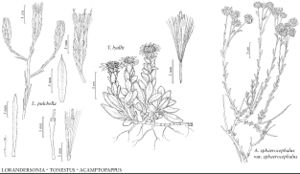Difference between revisions of "Acamptopappus"
Proc. Amer. Acad. Arts 8: 634. 1873.
imported>Volume Importer |
(No difference)
|
Latest revision as of 20:46, 29 July 2020
| Taxon | Illustrator ⠉ | |
|---|---|---|
 | Lorandersonia pulchella Tonestus lyallii Acamptopappus sphaerocephalus var. sphaerocephalus | John Myers Yevonn Wilson-Ramsey Barbara Alongi |
Shrubs, 20–40 cm (deciduous; taproots woody). Stems erect (older portions gray, usually with shredding bark), branched, spinescent with age, glabrous or hirtellous. Leaves cauline; alternate (sometimes in axillary fascicles); petiolate or sessile; blades (gray-green) 1-nerved, narrowly lanceolate or narrowly obovate or spatulate, margins entire, faces glabrous, scabrous, or scabro-hirtellous, eglandular. Heads radiate or discoid, borne singly or in loose corymbiform arrays (pedunculate). Involucres campanulate to hemispheric or globose, (4–13 ×) 7–16 mm. Phyllaries 13–25 in 3 series, appressed (reflexing at maturity, bases yellowish, apices green), 1-nerved (flat), broadly ovate to elliptic-ovate, unequal, margins broadly hyaline, lacerate, faces glabrous. Receptacles flat to slightly convex, deeply pitted (pit margins ± lacerate), epaleate. Ray-florets usually 5–14, sometimes 0, pistillate, fertile; corollas yellow. Disc-florets 13–45, bisexual, fertile; corollas yellow, tubes longer than funnelform throats, lobes 5, reflexed, lanceolate; style-branch appendages triangular-lanceolate. Cypselae obconic, compressed, nervation not evident, faces densely sericeous to villous (some hairs ascending-spreading, others appressed and tortuous); pappi persistent, of 18–22, variably thick, broadly flattened, subequal, marginally barbellate or barbellulate to smooth, apically attenuate (ray) to spatulate (disc), setiform scales (heights equaling disc corollas) in 1–2 series, plus much shorter bristles or setae. x = 9.
Distribution
sw United States
Discussion
Species 2 (2 in the flora).
Acamptopappus is essentially endemic to the Mojave Desert of California, Arizona, Nevada, and Utah. The genus is recognized as low, white-barked, desert shrubs with pedunculate heads, borne singly or in loose, corymbiform arrays, with ovate phyllaries with broad hyaline margins, 0 or 5–14 yellow rays, sericeous to villous cypselae, and thick pappus scales.
Selected References
Lower Taxa
Key
| 1 | Heads borne singly; involucres campanulate to hemispheric, 7–10 mm wide; rays 5–14 | Acamptopappus shockleyi |
| 1 | Heads in loose, corymbiform arrays; involucres hemispheric to globose, 8–16 mm wide; rays 0 | Acamptopappus sphaerocephalus |
"[" is not declared as a valid unit of measurement for this property."]" is not declared as a valid unit of measurement for this property.